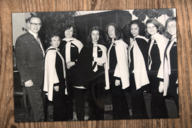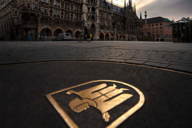
The Münchner Kindl lives in the town hall on Marienplatz. At any rate, it can be discovered there in countless variations: as the city coat of arms on the doorway, on a fresco in the stairwell and high up on the city hall tower. At the last championship celebration on the Town Hall balcony, the FC Bayern players must have fallen head over heels in love with the Kindl, because from now on Müller, Lewandowski, Sané & Co. proudly wear its image on their away jerseys out into the world. How long has the Münchner Kindl actually existed?
- Historical facts about the Münchner Kindl
- From mascot to advertising icon
- Prominent Münchner Kindl
- FAQ
Munich was first mentioned in documents in 1158 as "Munichen". Because of the similarity to the Latin word for monk and because the areas surrounding Munich belonged to the monastery of Schäftlarn, the speaking city coat of arms with the monk developed from the 13th century onwards. The figure was initially depicted only from the chest up, then from the 14th century onwards became a full-length representation complete with a book of scripture and a gesture of benediction. The monk remains an integral element of the city’s coat of arms to this day. Since 1957, all of the city’s offices and institutions have used a particular design of the Münchner Kindl as their emblem.
Time has been unusually kind to Munich’s heraldic emblem, as it has actually become younger through the centuries. Following the fashion of the times, it changed from being represented as an adult monk to a genderless, childlike being; for a time, the figure was depicted with alternating gender presentations, before a female form for the Kindl became established in the 1920s.
One important date in the long life of the Kindl is the year 1847. A drawing from the time, by artist Kaspar Braun, portrays the Kindl stepping out of the imprisoning frame of the municipal coat of arms, released to assume an independent identity as a mascot and advertising icon. From that moment, there was no holding it back. The Münchner Kindl is an inveterate socialite who pops up in all kinds of places.
It has even exchanged its book of scripture for a stein of beer, in service of the burgeoning brewing industry. From 1890, the Münchner Kindl adorned postcards and souvenirs, thereby becoming a friendly figurehead featuring in tourist advertising for the city. The Kindl also showed off an international outlook at an early stage, when it appeared on a poster for the 1910 Munich exhibition of Islamic art, alongside an Arabian guitarist and wearing that icon of North African headwear, the fez.
The Kindl actually dominated the entire Munich advertising industry right up until the First World War: clubs bore its name, more than 130 Munich companies used the figure in their advertising, and the Kindl Kutte (Kindl cowl) became a popular costume for the carnival season of Fasching. Folk singers and comedians such as Karl Valentin, Liesl Karlstadt and Weiss Ferdl all had a Münchner Kindl number in their acts.

In the run-up to the 1972 Summer Olympics, hostesses at official receptions would also wear the black and gold Münchner Kindl cowl – a look which led to the women being given the affectionately mocking nickname of “Vatican Airlines”. The official Munich emblem did not make an appearance during the actual Olympic Games though, as it was supplanted from the mascot role by the colourfully banded Dackel Waldi dachshund. Hostesses – among them the future Swedish Queen Silvia – wore light blue dirndls at events instead.
The Münchner Kindl title is also bestowed on all those born in Munich, usually accompanied by the term “waschecht”, meaning “genuine”. Prominent “waschecht” Munich Kindls include the Empress Sisi and King Ludwig II, composer Richard Strauss, painters Carl Spitzweg and Franz Marc, Charlotte Knobloch, President of the Israelitische Kultusgemeinde München und Oberbayern (Jewish Community of Munich and Upper Bavaria), star tenor Jonas Kaufmann, footballers Philipp Lahm and Franz Beckenbauer, Criminal Investigator Udo Wachtveitl and actor Elyas M’Barek.

20-year-old Franziska Inselkammer is another “waschecht” Münchner Kindl. She has also been the official Münchner Kindl since 2023, a role which comes with the duty of leading the Einzug der Wiesnwirte (grand entrance of the Oktoberfest hosts) as well as the world-famous Trachten- und Schützenzug (traditional costume and riflemen’s procession) on horseback on the first weekend of the Oktoberfest each year. One of the most beautiful moments for the passionate rider is when she finally mounts her horse for the entrance on the first Saturday of the Oktoberfest and knows that it's time to go, and then the horse-drawn carriages of the Wiesn innkeepers start moving behind her from Sonnenstrasse to the Oktoberfest grounds.
At the subsequent traditional Anzapfen (tapping of the first keg) in the Schottenhamel festival tent, she stands by the side of Munich's Lord Mayor. Franziska is the latest in a long line of Munich women chosen by the Festring München e.V association since 1938 to represent the Münchner Kindl. The first official Kindl, Ellis Kaut, is best known as the author who created the goblin Pumuckl.
Also interesting: At the Museums & Palaces in Bavaria Infopoint in the Altes Hof, the development of Munich's city coat of arms "from the monk to the Münchner Kindl" is shown using historical seals, coins and medals.